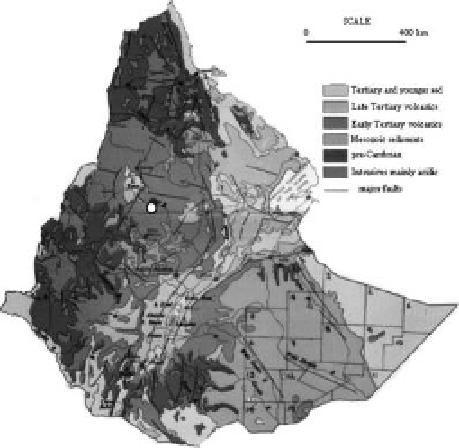Environmental Engineering Reference
In-Depth Information
The suitability of volcanic tuff from the ethiopian plateau
for earth dam construction and foundation
e.e. alonso & e. Romero
Department of Geotechnical Engineering and Geosciences, UPC, Barcelona, Spain
aBsTRacT: The intended site for the dam is located in a wide valley of the Gilgel abbay River with
an overall elevation difference between the upper plateau and the river level of about 85 m. The river has
eroded a series of volcanic rock units of early Tertiary origin, with alternative levels of basaltic lava flows
and ash or tuff deposits. The lava flows result in hard to medium rocks, jointed and fractured. The two
volcanic units mentioned (lava flows and tuffs) are approximately laid in a horizontal manner. Tuffs and
ash deposits, which have a very similar appearance, are white in colour and they are clearly identified when
exposed. They constitute the substratum of a dominant proportion of the dam foundation. They tend to
produce gentle slopes and, in the lower cultivated plots they are covered by alluvial clays. The exposed tuff
is not cultivated. The exposed tuff is eroded by running waters and it shows erosion patterns similar to
other soft clayey rocks. The resulting erosion forms tend to be rounded. however no firm evidence of pip-
ing was observed. The paper reports laboratory experiments on specimens of the intact tuff material. The
suitability of the tuff, once compacted, as a core material for a zoned-earth dam was also investigated.
1
inTRoDUcTion
at the Geotechnical laboratory of the civil engi-
neering school of Barcelona.
The two volcanic units mentioned (lava flows
and tuffs) are approximately laid in a horizontal
manner. Tuffs (this terms will be used also for the
ash deposits which, have a very similar appearance)
are white in colour and they are clearly identified
current projects to develop the lake Tana District
in ethiopia involve the construction of dams for
water supply and irrigation purposes. This paper
refers to the studies carried out during the design
of an earth and rockfill dam in the area (
Figure 1
).
The project is located in the central volcanic pla-
teau of the country. Mantles of Tertiary and Pleis-
tocene volcanic rocks and soils have been eroded
by the river network, which eventually discharge
into the lake Tana.
The valleys were excavated in a sequence of
basaltic and rhyolitic rocks and volcanic ash and
tuffs (
Figure 2
). This paper describes the geotech-
nical investigations performed to characterize the
volcanic tuffs in view of its suitability as founda-
tion soils for dams. in addition, the possibility of
using tuffs as a compacted material in the dam core
or shoulders was also investigated.
The main aspects addressed in this paper refer to
the strength, permeability and dispersion suscepti-
bility of these materials. intact material properties
were investigated in rock cores recovered during the
site investigation for the intended dam. compacted
materials were manufactured by crushing cores and
passing #4 asTM sieve, mixing material them with
water and compacting samples in the usual man-
ner (repeated tamping or static compaction; stand-
ard Proctor was the reference compaction energy).
Most of the tests reported here were performed
Figure 1.
location of the project.














